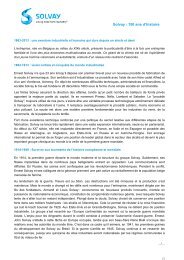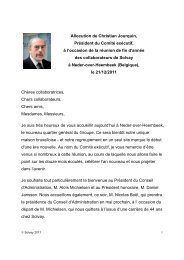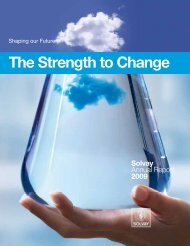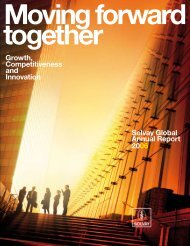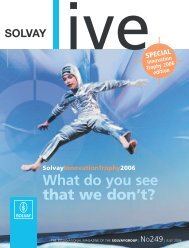THE FUTURE, - Solvay
THE FUTURE, - Solvay
THE FUTURE, - Solvay
Create successful ePaper yourself
Turn your PDF publications into a flip-book with our unique Google optimized e-Paper software.
209134 209172 209750<br />
F2 SATELLITE PLANT<br />
Fluorine production<br />
at client facilities<br />
<strong>THE</strong> PROJECT. <strong>Solvay</strong> Fluor manufactures<br />
elemental fl uorine (F2) at its sites in Bad Wimpfen<br />
(Germany) and Onsan (Korea). For some time now<br />
<strong>Solvay</strong> Fluor has been investigating the possibility<br />
to replace NF3 by <strong>Solvay</strong>’s elemental fl uorine (F2)<br />
for CVD (chemical vapour deposition), for use in<br />
chamber cleaning in the fl at panel (LCD) and thin<br />
fi lm photovoltaic industries. F2 has a higher<br />
effi ciency than NF3 and a zero GWP (global<br />
warming potential) compared with more than<br />
10 000 GWP for NF3, making it a perfect fi t with<br />
the Group’s sustainability strategy. If we are<br />
successful, the market potential is enormous: a<br />
single PV or LCD plant can consume several ten<br />
to hundred tons per year of pure F2!<br />
Based on this fact, <strong>Solvay</strong> Fluor developed the<br />
only rational solution to offer to its customers:<br />
a unique modular “F2 satellite” concept for<br />
on-site F2 production, avoiding F2 transport while<br />
ensuring continuous, uninterrupted F2 supply.<br />
This allows the customers to achieve signifi cant<br />
investment savings, while <strong>Solvay</strong> Fluor avoids<br />
accumulating stocks at the customer sites,<br />
investment in packaging and shipping costs.<br />
<strong>Solvay</strong> Fluor, with its more than 35 years of<br />
experience in the manufacturing and handling of<br />
F2, is working on several fronts in close<br />
cooperation with major CVD chamber suppliers<br />
as well as end-users. The F2 satellite concept is<br />
easily replicable on different sizes and is being<br />
considered in various countries. A new high purity<br />
F2 is available to serve the semiconductor<br />
industry in addition to the fast growing PV and<br />
LCD markets.<br />
SBU FLUOR<br />
> Michael Pittroff; Seung-Bong Choi;<br />
Francis Feys; Dae-Jun Han; Udo Landmesser;<br />
Mark Looney; André Nothomb; Marcello Riva;<br />
Robert Schmitt.<br />
SILICATED SODIUM BICARBONATE AS<br />
A NEW AND SAFE SOLUTION TO COMBAT<br />
PARASITES<br />
An end to parasites<br />
<strong>THE</strong> PROJECT. Parasites such as lice in<br />
children, red chicken mite in poultry farms<br />
and insects in grain silos adapt and eventually<br />
become unresponsive to conventional<br />
insecticides.<br />
The proposed solution, based on sodium<br />
bicarbonate, has proved its effectiveness, and<br />
its ‘physical’ means of operation rules out any<br />
possible adaptation of parasites.<br />
Mixing well-known products (sodium bicarbonate<br />
and silica) that are harmless to humans and<br />
animals gives a ‘silicated’ sodium bicarbonate<br />
used in the form of powder or gel.<br />
This mixture acts by physical effect: dehydrating<br />
and / or suffocating the pests that have thus no<br />
chance to mutate and adapt.<br />
These new products are being manufactured<br />
and developed in partnerships in Italy, France<br />
and Spain. This approach to new markets through<br />
partnership was presented and awarded during<br />
the 2006 <strong>Solvay</strong> Innovation Trophy. Initial market<br />
response is good.<br />
SBU SODA ASH<br />
> Olivier Patat; Pierfrancesco Morganti;<br />
Jean-Philippe Pascal; Magali Riglet;<br />
Giordanao Zapel.<br />
APPLICATION OF <strong>THE</strong> ‘ZERO EFFLUENT’<br />
CONCEPT TO <strong>THE</strong> WASTEWATER FROM<br />
MEMBRANE ELECTROLYSIS AND VINYL<br />
CHLORIDE PROCESSES IN RUSSIA<br />
PVC: ultra-clean plant<br />
<strong>THE</strong> PROJECT. <strong>Solvay</strong> has developed a<br />
technology – unique in the world to our<br />
knowledge – to treat effl uent from the vinyl chain<br />
for recycling as raw material for the manufacture<br />
of PVC.<br />
This advanced technology demonstrates that<br />
emissions into the environment can be further<br />
reduced where a new vinyl production unit is set<br />
up in a sensitive area where legislation is<br />
particularly strict.<br />
More precisely, the project is to treat an<br />
electrolysis effl uent and another effl uent from<br />
the production of vinyl chloride, the monomer<br />
precursor of PVC. The nature of these treatments<br />
remains confi dential at this stage, because<br />
intellectual protection procedures are underway.<br />
Pilot projects have been conducted successfully<br />
at Rosignano (Italy) and Dombasle (France).<br />
Industrial implementation is foreseen in the new<br />
PVC production unit (330 000 tons / year) at<br />
Kstovo in the region of Nizhny Novgorod (Russia).<br />
CC HSE, SBU EDS<br />
> Nathalie Swinnen; Attilio Bargagli;<br />
Ward Blancke; Luc Botte; Pierre Coërs;<br />
André Daene; Alain Fobelets; Patrick Gilbeau;<br />
Alain Hanneuse; Ines Hurtado; Philippe Krafft;<br />
Joao Marques; Marco Paci; Alessandra Pastacaldi.<br />
<strong>Solvay</strong> live - JULY 2009 - 21



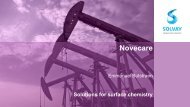
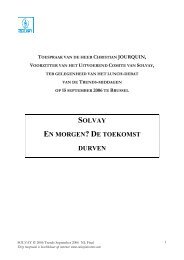
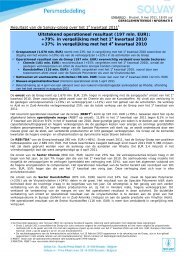

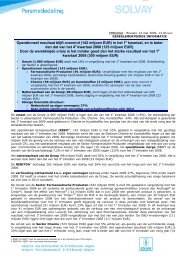
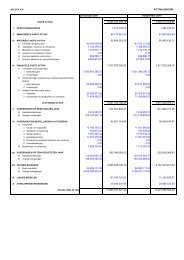

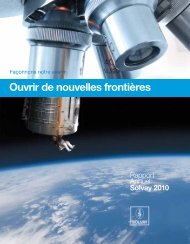
![PROC.1 [LETTRE] - Solvay](https://img.yumpu.com/16585746/1/184x260/proc1-lettre-solvay.jpg?quality=85)
